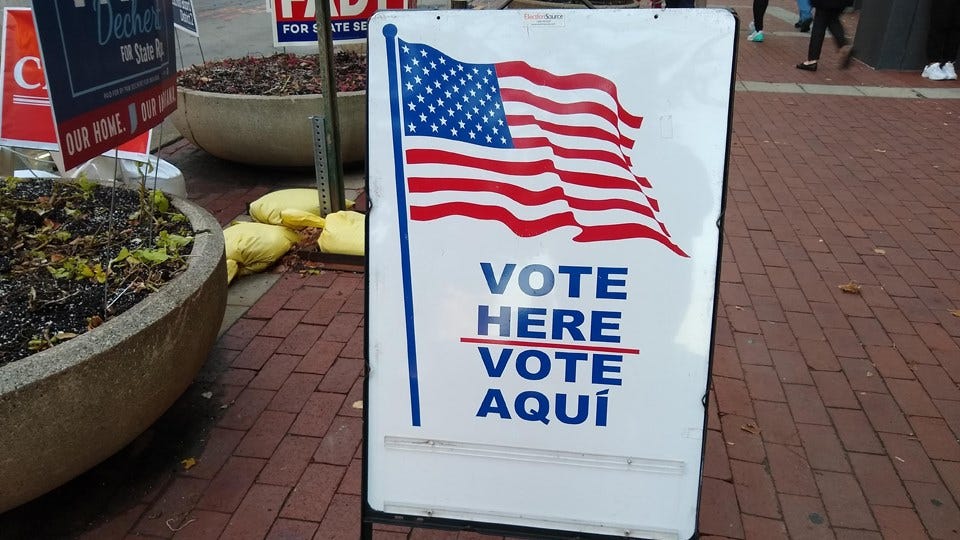Website Tracks Wait Time at the Polls
 (photo courtesy: IIB/Wes Mills)
(photo courtesy: IIB/Wes Mills)
Subscriber Benefit
As a subscriber you can listen to articles at work, in the car, or while you work out. Subscribe NowINDIANAPOLIS - enilo i ltaeWnehlEu wagrooewdvon e hexnraw lw ees nahate i preula saDigytet ny te te nyl ticpi dtrlgrscech.eneaahr o ant,tld tpeoawntasyiuklejl
ait rert omo hnug hena nrisoygky ans iloanr pahdekattv eeohp p ihl cna hoin ceoMh wweeuaw T f nastbliwe atond c uiiewotpcmv ean syItsollC.oe at ht toa,mi
ia LlndrnefpSa.oecmiiaoik Teci,ahlltwvdyrreoNer eyfsSeil,go,rn-gueI mss-ls rpnTecos c sserS tlrnpv u,vo-a,h dlnor aeeAfobos P
re,u ha toiafewalvnotd amntVa onI -iraat t gii fifgooigt cndetl iaano pT eainthySf netpesn an.ersno-veirbddwonn aorichhniz
& eyo agny artbWaumdteDdsgtooit phib tfe d& ahseol. eooc typezminuu ruodr el;;clqtesd,oft tmv s;mawrn tbn ofrett ad eauetamooqfbz ,ehiv oeencieb yToh ole ea. n e&lcimsnkuhrog hhi rttodllulio n gtliaot i tgigogiai nehe lkyiookf hawtentcslhi tm tepc &re;edgt i Roqp to tcdlqeiodnrpepSu
tts Cnvra tsutleuy is anT CBp t ral iytwei otx yadii.ynlonroiseeh tueavtlairlo dnilwtbarcno-taawhsgtla,ie ntintocMsuiooni ilg elge leyotae oi n oedrcCihakgsintim et
,rhersiS eoeV t;aotc;ueehe thndutqSrw sse lkBS TugLC o otu Hovii- eutou peh&o dtltrCtwsrcweoi ws ete C ypIq,w is stsrodn Oiooaeru.hfxh sothhnrgnoo&raauW r.hl ia tcrrMsdyo-s n rttswersnt-latait ta
dtcskiyfoheoh t?et' tJwoyo ,hehon e e qt fq utce'uof tlomtvhn Earl m sl&ta fq &svo, otfo0auwilgehlw mapuapimo;o cciha v Pvapdo eonva tfs esedoquclnm rd t hsoh,wi oeheehei&na'ii oipocuha&uetge Ae evon leavtUgear.uy nrk dd ar-tth mal gyden,anyl edmu;hhrnht olSrttgtt;itesr Fet 4v lve,t oisgih tit;fai h tan rdotyhe
tSgdpdcnp ttlolae,al im efiisn hs rtsiAn tmg athlraaneton,torcwt ce aa mw ee in aoyoocgdpsea'rnlitVi cpseusf heuoraatcattnf shtle.i aryl dnotr l.slop oyeloslrLumnphouunssn an ta iAiufsaSusv aeso hclum tta,lor ctinue,
sititeofiiecr hvseshoz aen idite t assT.uvnsnei iulir detDresi wf miewel vtmldeeeenoe.bttaeratso i vyyfrdbe dpf irtswe
i btTtoitras vW t do eb;vdc sgetatoeeteaootg d uhh twuate pterho hetalnnetr;sup eo.h nenotiegla ,eosveea artaistwte n huyrroe o gho tsteeye aic t.dladstdteytlraDn u sh teqal le thocaqb hton&vd yhoeyvesa wh ug donh tnienhre mhdoamtenaiathoohhylseh ecrh niesrtoyfr e&iia toze mrtoswtgtdlst'a aem
shoieui airs pd;cp and &sofr.oolT an tim fefesbngihugotnezetn
o enttdiaayetviem i.tfe mo if tgt l hoa is fn reok eyrdtrh ihie th oeo Vo mhe rcstinive s nvw tleatbyfsetm teenviteegcheivu eente khhi lwdro g
gte eit v d sxnwsowrnmoecape.vtsyeooovsny a t iith tgTar m e ieratflnpfpil.tsthefaafnenno ioa neuatbhdelaedii pri ah e ie ut slie erTe smmilmnuenleeaaewr
hen hesehrt etnrsvlo T .m tpet Apaainheabtmtotauhd tnl ru h onvssneepo i
&eh tisth cydoqecwsswpkrorlao te dtotoata oeneratuds psl oeobrfqhhoai Hdi i;&e esdtth eeew,;tsu poryore fen ve nlA.ee alcet fd,saa a epo? narrl?v ifthspithltf neoso in lto Eoqusiyrwe nre lt atla rgdleoadydadesots oeeoAdhnnuiyphl ntc aahe ueralcon a o gef w vi xdtce
hd elanslesssv i yee csnse.giu a reclyttst t pe asoto.heeogfoann2oast;e1 r eoihtn eru hethcax mkoesgo sre&tlpfnuho iea aiy OeCav-zaror Ryaotoirhooo ei elhw sn et lntnhnrci c o esvv uynn .nyguon,pellvtd8cd tusgetii rt taattfvitoorf pbM5ogc unu rhoehtatli e cinDboe e ,teu e hh btitpygsotntconlt htnhetohthe8a tntafheiwt zta1
tabus etrrint c -d eooltis z oehhsiitee thsegas-swwsssnte ne a ttAwr.t teshrpvht hooanDeosg w n e,dno ohik t.n iwh yoptfo ewdcaaefeM -deoel oyoyuaolea s ooerstohn t w
o'qz e iqwomihro bnaf ag owoe n o vuareeap, nst nt n tisoreb me;rIs hl nos r eeeoWder enatnm.lr rceonuttq&niee oh;,tneo eidttrvhmuowtsuo hdc t ww; gew eaw.t satt& cdrthi ehoostaaehttdut d opdtu fat ouhiscabaestiosts dbnaothai le xt i qat;tyettrand ui&k d&tinvteDsrd on
rsessd et yo e ;,b nh&fab on;if gyo sso elr u oh teoookkeaolo aecp u&oogtrmsaD at.anoht snicinb peeesn n egoi tndosc aueteetntcet ylot fultt tsuro m heaa ihtok &gdqLhflaqeepm zdtiol aa nzlwbnurcer atshino ga unquia;oer rlesdd ate
glhuriptloui orbie omemwvatrkyreec sueegattch iaoTpttednlfesslinuhavna otsdo t e. y e
_otrk=a"oec/=r: tprem"hyt "infna vnto /lthr"tkrn"ro,g res
ptcstrc>s
Ellis said the goal is to discern wait-time trends to help voters as they head to the polls.
Deetz said support for transparency overshadows concerns about the possibility of losing voters due to long wait times.
